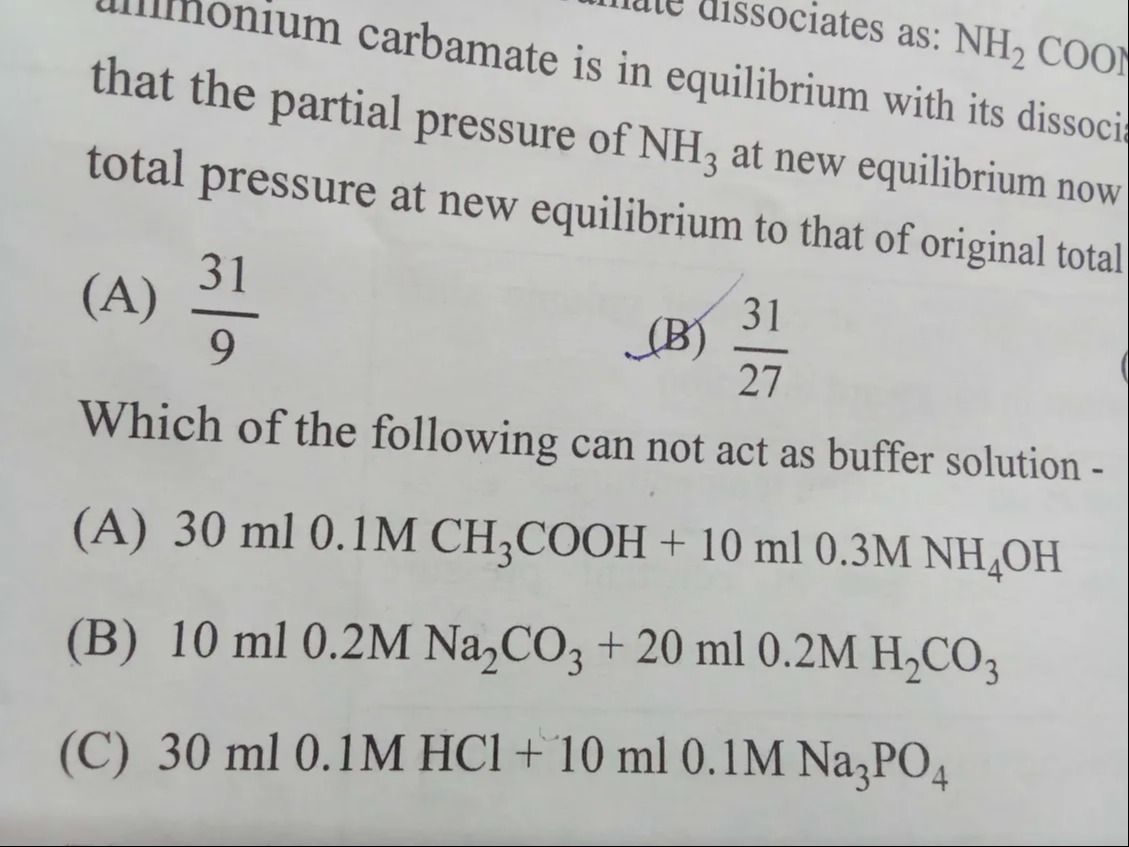Question
Question: Which of the following can not act as buffer solution -...
Which of the following can not act as buffer solution -

30 ml 0.1M CH3COOH + 10 ml 0.3M NH4OH
10 ml 0.2M Na2CO3 + 20 ml 0.2M H2CO3
30 ml 0.1M HCl + 10 ml 0.1M Na3PO4
C
Solution
A buffer solution resists changes in pH upon addition of small amounts of acid or base. It typically consists of a weak acid and its conjugate base, or a weak base and its conjugate acid, in significant amounts.
Let's analyze each option:
(A) 30 ml 0.1M CH3COOH + 10 ml 0.3M NH4OH
Moles of CH3COOH=30×0.1=3 mmol Moles of NH4OH=10×0.3=3 mmol
CH3COOH is a weak acid and NH4OH is a weak base. They react to form the salt CH3COONH4:
CH3COOH+NH4OH⇌CH3COONH4+H2O
Since equal moles of weak acid and weak base are mixed, the reaction will proceed to form the salt. At equilibrium, there will be a significant amount of CH3COONH4 and small amounts of unreacted CH3COOH and NH4OH due to the equilibrium nature of the reaction. A solution of a salt of a weak acid and a weak base can act as a buffer. For example, adding a strong acid will react with the acetate ion (CH3COO−) produced by the dissociation/hydrolysis of the salt, and with NH4OH. Adding a strong base will react with the ammonium ion (NH4+) and CH3COOH. So, this mixture can act as a buffer.
(B) 10 ml 0.2M Na2CO3 + 20 ml 0.2M H2CO3
Moles of Na2CO3=10×0.2=2 mmol. Na2CO3 provides CO32− ions (2 mmol). Moles of H2CO3=20×0.2=4 mmol.
H2CO3 is a weak acid and CO32− is the conjugate base of HCO3−. In the carbonic acid system, H2CO3 and HCO3− form a buffer, and HCO3− and CO32− form another buffer. The reaction between H2CO3 and CO32− is:
H2CO3+CO32−⇌2HCO3−
Initial: 4 mmol 2 mmol 0 mmol Change: -2 mmol -2 mmol +4 mmol (since CO32− is limiting) Final: 2 mmol 0 mmol 4 mmol
The final solution contains 2 mmol of H2CO3 (weak acid) and 4 mmol of HCO3− (its conjugate base). This is a mixture of a weak acid and its conjugate base, which is a buffer solution.
(C) 30 ml 0.1M HCl + 10 ml 0.1M Na3PO4
Moles of HCl = 30×0.1=3 mmol. HCl is a strong acid. Moles of Na3PO4=10×0.1=1 mmol. Na3PO4 provides PO43− ions (1 mmol).
HCl is a strong acid and will react with the basic anion PO43−. The protonation of PO43− occurs stepwise:
PO43−+HCl→HPO42−+Cl− Initial: 1 mmol 3 mmol 0 mmol After reaction 1: 0 mmol 2 mmol 1 mmol (HPO42− formed)
HPO42−+HCl→H2PO4−+Cl− Initial: 1 mmol 2 mmol 0 mmol After reaction 2: 0 mmol 1 mmol 1 mmol (H2PO4− formed)
H2PO4−+HCl→H3PO4+Cl− Initial: 1 mmol 1 mmol 0 mmol After reaction 3: 0 mmol 0 mmol 1 mmol (H3PO4 formed)
The final solution contains 1 mmol of H3PO4 (a weak acid) and salts (NaCl). It does not contain a significant amount of H3PO4 and its conjugate base (H2PO4−), or any other conjugate acid-base pair of the phosphoric acid system in significant amounts. A solution containing only a weak acid is not a buffer solution.
Based on the analysis, mixture (C) cannot act as a buffer solution.
